The Soul City Television Series: A Sociological Perspective
VerifiedAdded on 2020/03/23
|9
|1888
|58
Essay
AI Summary
This essay provides a comprehensive analysis of the Soul City television series, a South African program that aimed to address social and health issues through entertainment. The essay examines the series' entertainment function and its role in shaping societal behaviors, particularly concerning health, gender stereotypes, and social change. It discusses the show's use of edutainment strategies, media advocacy, and community engagement to influence attitudes and practices. The analysis considers the series' portrayal of gender roles, its impact on challenging stereotypes, and its contribution to public discourse on critical social issues, including HIV/AIDS awareness and gender equality. The essay also explores the production theory, communication strategies, and the role of media in mediating and enhancing social myths and stereotypes. The essay uses various sources to support the arguments and provide a detailed understanding of the Soul City television series' influence on South African society.
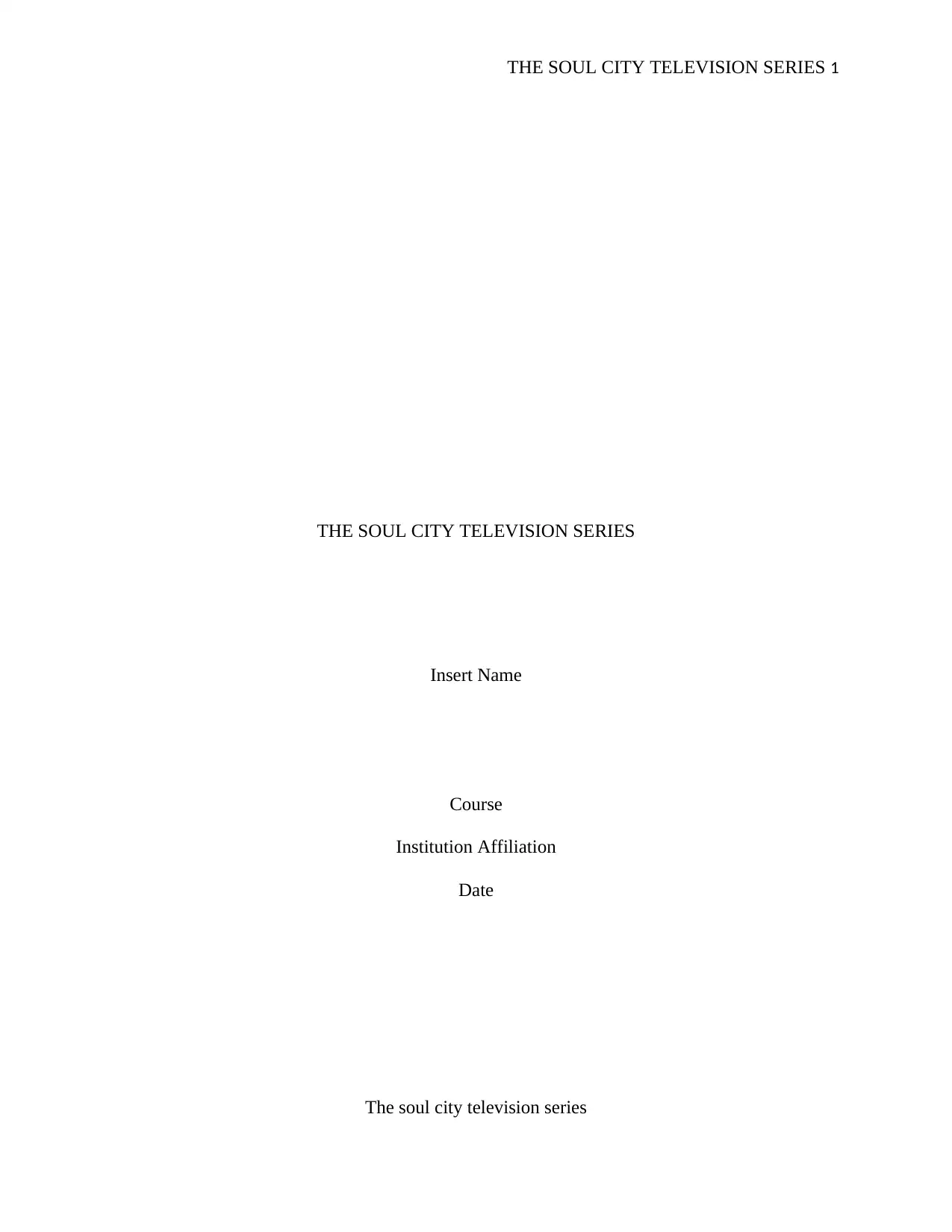
THE SOUL CITY TELEVISION SERIES 1
THE SOUL CITY TELEVISION SERIES
Insert Name
Course
Institution Affiliation
Date
The soul city television series
THE SOUL CITY TELEVISION SERIES
Insert Name
Course
Institution Affiliation
Date
The soul city television series
Paraphrase This Document
Need a fresh take? Get an instant paraphrase of this document with our AI Paraphraser
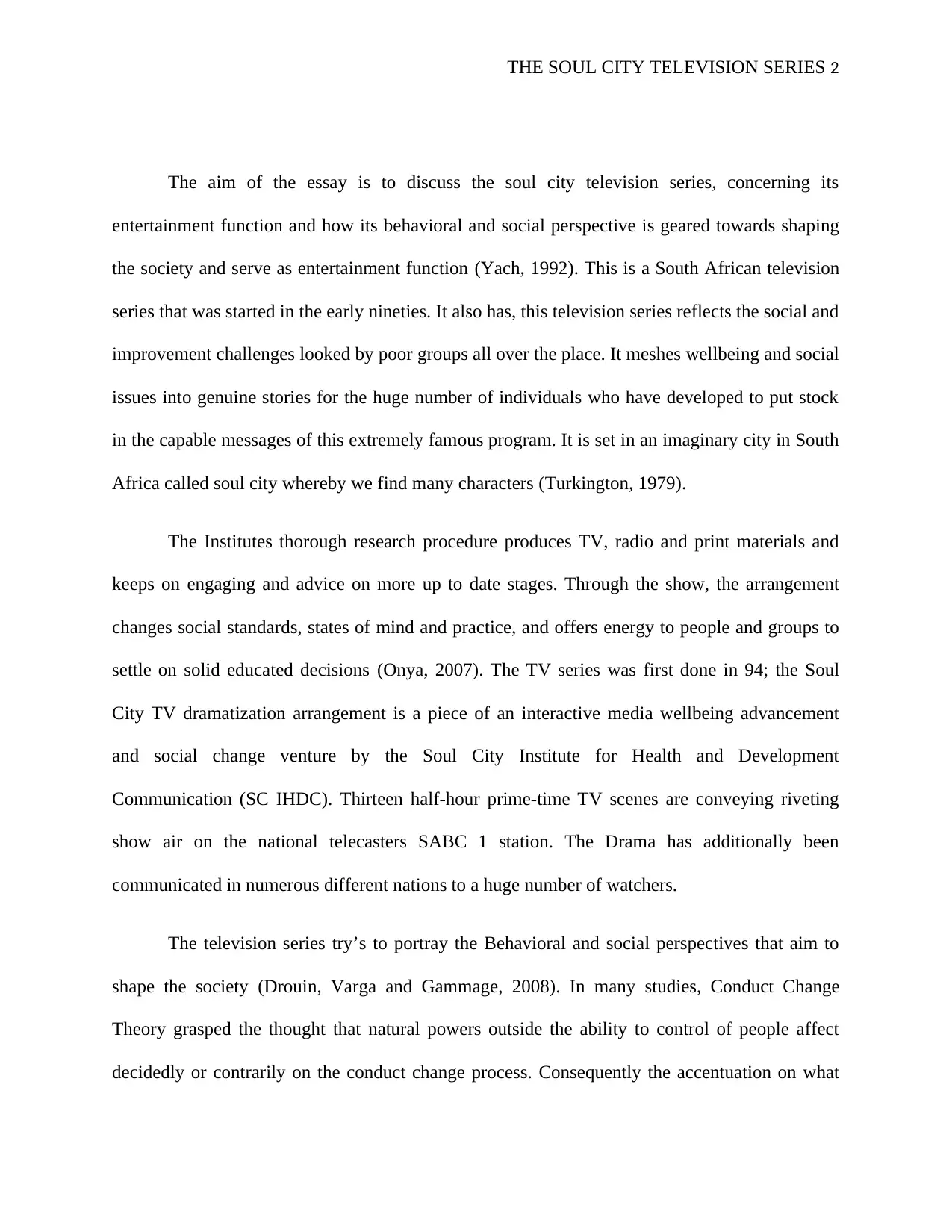
THE SOUL CITY TELEVISION SERIES 2
The aim of the essay is to discuss the soul city television series, concerning its
entertainment function and how its behavioral and social perspective is geared towards shaping
the society and serve as entertainment function (Yach, 1992). This is a South African television
series that was started in the early nineties. It also has, this television series reflects the social and
improvement challenges looked by poor groups all over the place. It meshes wellbeing and social
issues into genuine stories for the huge number of individuals who have developed to put stock
in the capable messages of this extremely famous program. It is set in an imaginary city in South
Africa called soul city whereby we find many characters (Turkington, 1979).
The Institutes thorough research procedure produces TV, radio and print materials and
keeps on engaging and advice on more up to date stages. Through the show, the arrangement
changes social standards, states of mind and practice, and offers energy to people and groups to
settle on solid educated decisions (Onya, 2007). The TV series was first done in 94; the Soul
City TV dramatization arrangement is a piece of an interactive media wellbeing advancement
and social change venture by the Soul City Institute for Health and Development
Communication (SC IHDC). Thirteen half-hour prime-time TV scenes are conveying riveting
show air on the national telecasters SABC 1 station. The Drama has additionally been
communicated in numerous different nations to a huge number of watchers.
The television series try’s to portray the Behavioral and social perspectives that aim to
shape the society (Drouin, Varga and Gammage, 2008). In many studies, Conduct Change
Theory grasped the thought that natural powers outside the ability to control of people affect
decidedly or contrarily on the conduct change process. Consequently the accentuation on what
The aim of the essay is to discuss the soul city television series, concerning its
entertainment function and how its behavioral and social perspective is geared towards shaping
the society and serve as entertainment function (Yach, 1992). This is a South African television
series that was started in the early nineties. It also has, this television series reflects the social and
improvement challenges looked by poor groups all over the place. It meshes wellbeing and social
issues into genuine stories for the huge number of individuals who have developed to put stock
in the capable messages of this extremely famous program. It is set in an imaginary city in South
Africa called soul city whereby we find many characters (Turkington, 1979).
The Institutes thorough research procedure produces TV, radio and print materials and
keeps on engaging and advice on more up to date stages. Through the show, the arrangement
changes social standards, states of mind and practice, and offers energy to people and groups to
settle on solid educated decisions (Onya, 2007). The TV series was first done in 94; the Soul
City TV dramatization arrangement is a piece of an interactive media wellbeing advancement
and social change venture by the Soul City Institute for Health and Development
Communication (SC IHDC). Thirteen half-hour prime-time TV scenes are conveying riveting
show air on the national telecasters SABC 1 station. The Drama has additionally been
communicated in numerous different nations to a huge number of watchers.
The television series try’s to portray the Behavioral and social perspectives that aim to
shape the society (Drouin, Varga and Gammage, 2008). In many studies, Conduct Change
Theory grasped the thought that natural powers outside the ability to control of people affect
decidedly or contrarily on the conduct change process. Consequently the accentuation on what
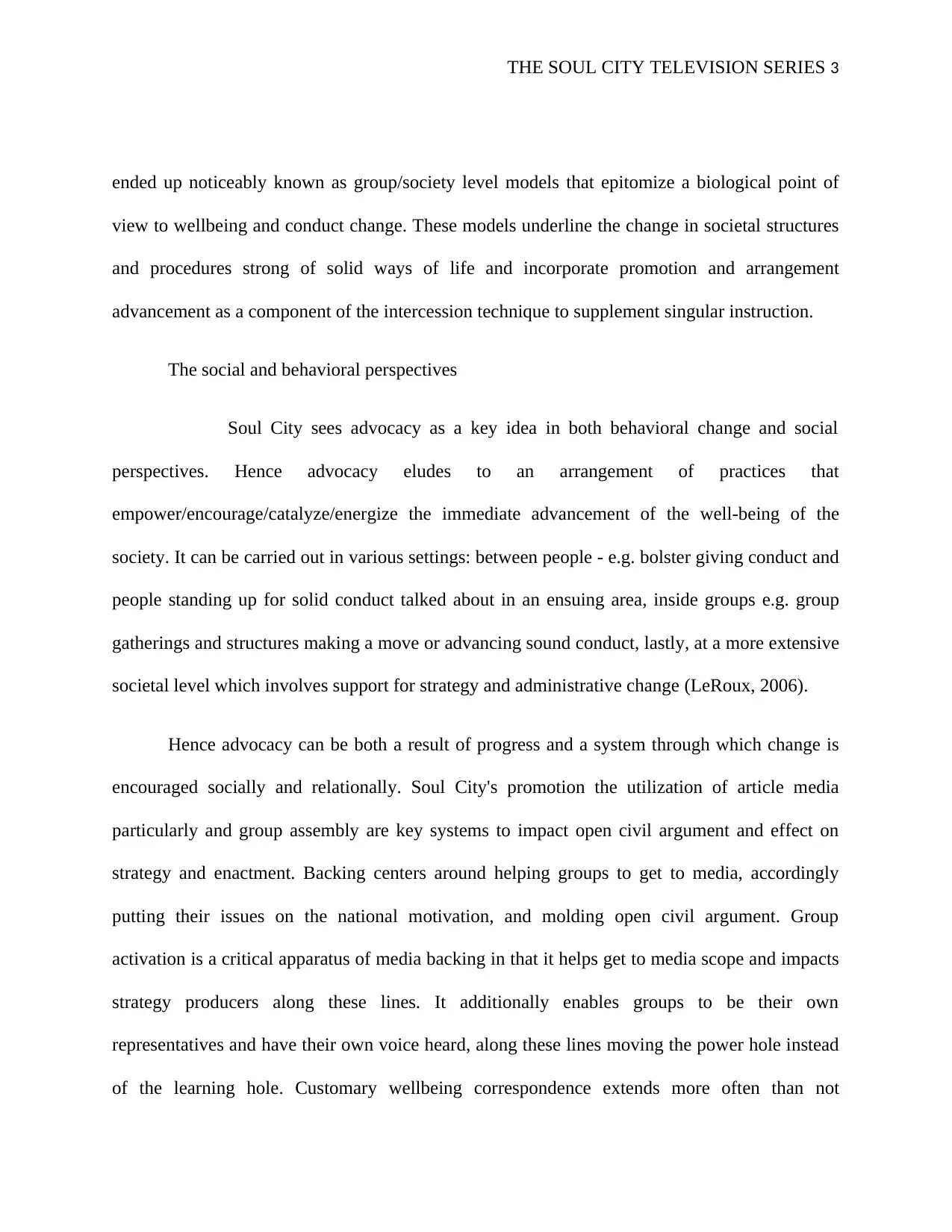
THE SOUL CITY TELEVISION SERIES 3
ended up noticeably known as group/society level models that epitomize a biological point of
view to wellbeing and conduct change. These models underline the change in societal structures
and procedures strong of solid ways of life and incorporate promotion and arrangement
advancement as a component of the intercession technique to supplement singular instruction.
The social and behavioral perspectives
Soul City sees advocacy as a key idea in both behavioral change and social
perspectives. Hence advocacy eludes to an arrangement of practices that
empower/encourage/catalyze/energize the immediate advancement of the well-being of the
society. It can be carried out in various settings: between people - e.g. bolster giving conduct and
people standing up for solid conduct talked about in an ensuing area, inside groups e.g. group
gatherings and structures making a move or advancing sound conduct, lastly, at a more extensive
societal level which involves support for strategy and administrative change (LeRoux, 2006).
Hence advocacy can be both a result of progress and a system through which change is
encouraged socially and relationally. Soul City's promotion the utilization of article media
particularly and group assembly are key systems to impact open civil argument and effect on
strategy and enactment. Backing centers around helping groups to get to media, accordingly
putting their issues on the national motivation, and molding open civil argument. Group
activation is a critical apparatus of media backing in that it helps get to media scope and impacts
strategy producers along these lines. It additionally enables groups to be their own
representatives and have their own voice heard, along these lines moving the power hole instead
of the learning hole. Customary wellbeing correspondence extends more often than not
ended up noticeably known as group/society level models that epitomize a biological point of
view to wellbeing and conduct change. These models underline the change in societal structures
and procedures strong of solid ways of life and incorporate promotion and arrangement
advancement as a component of the intercession technique to supplement singular instruction.
The social and behavioral perspectives
Soul City sees advocacy as a key idea in both behavioral change and social
perspectives. Hence advocacy eludes to an arrangement of practices that
empower/encourage/catalyze/energize the immediate advancement of the well-being of the
society. It can be carried out in various settings: between people - e.g. bolster giving conduct and
people standing up for solid conduct talked about in an ensuing area, inside groups e.g. group
gatherings and structures making a move or advancing sound conduct, lastly, at a more extensive
societal level which involves support for strategy and administrative change (LeRoux, 2006).
Hence advocacy can be both a result of progress and a system through which change is
encouraged socially and relationally. Soul City's promotion the utilization of article media
particularly and group assembly are key systems to impact open civil argument and effect on
strategy and enactment. Backing centers around helping groups to get to media, accordingly
putting their issues on the national motivation, and molding open civil argument. Group
activation is a critical apparatus of media backing in that it helps get to media scope and impacts
strategy producers along these lines. It additionally enables groups to be their own
representatives and have their own voice heard, along these lines moving the power hole instead
of the learning hole. Customary wellbeing correspondence extends more often than not
⊘ This is a preview!⊘
Do you want full access?
Subscribe today to unlock all pages.

Trusted by 1+ million students worldwide

THE SOUL CITY TELEVISION SERIES 4
concentrate on getting people, in general, to find out about a medical problem and to change the
way they think or act therefore affecting on the information hole.
Analysis of entertainment function basing on the production theory
Soul city television series is very exceptional in terms of production. It is therefore
not just a TV series as it uses the drama as a tool to educate the society. It has been produced to
serve as entertainment and education drama. Edutainment is the procedure of purposive planning
and implementing a media message both to engage and instruct, keeping in mind the end goal to
build audience members' information around an instructive issue, make positive dispositions, and
change plain conduct (Richards, 2007). Soul City television arrangement is known as one of the
focal cases to gain from, and fill in as a key contribution to talks of the hypothetical difficulties
in Entertainment-Education, crusade organization, media promotion and key associations.
Task 4:
The dominant group is female. Women are widely represented and used in this television
series. The number of females outnumbers male. Through drama, the series changes social
customs, attitudes, and practices, and authorities to individuals and society to promote health.
Apparently, the drama is broadcasted in several other countries. Communication strategies the
programs have been plotted to affect the individual, the municipal, social and political context.
Its main audience is adults with some programs for youths (Soul Buddyz). The television is aided
by print; advocacy and radio campaigns intended to keep people discussing matters raised in the
play.
concentrate on getting people, in general, to find out about a medical problem and to change the
way they think or act therefore affecting on the information hole.
Analysis of entertainment function basing on the production theory
Soul city television series is very exceptional in terms of production. It is therefore
not just a TV series as it uses the drama as a tool to educate the society. It has been produced to
serve as entertainment and education drama. Edutainment is the procedure of purposive planning
and implementing a media message both to engage and instruct, keeping in mind the end goal to
build audience members' information around an instructive issue, make positive dispositions, and
change plain conduct (Richards, 2007). Soul City television arrangement is known as one of the
focal cases to gain from, and fill in as a key contribution to talks of the hypothetical difficulties
in Entertainment-Education, crusade organization, media promotion and key associations.
Task 4:
The dominant group is female. Women are widely represented and used in this television
series. The number of females outnumbers male. Through drama, the series changes social
customs, attitudes, and practices, and authorities to individuals and society to promote health.
Apparently, the drama is broadcasted in several other countries. Communication strategies the
programs have been plotted to affect the individual, the municipal, social and political context.
Its main audience is adults with some programs for youths (Soul Buddyz). The television is aided
by print; advocacy and radio campaigns intended to keep people discussing matters raised in the
play.
Paraphrase This Document
Need a fresh take? Get an instant paraphrase of this document with our AI Paraphraser
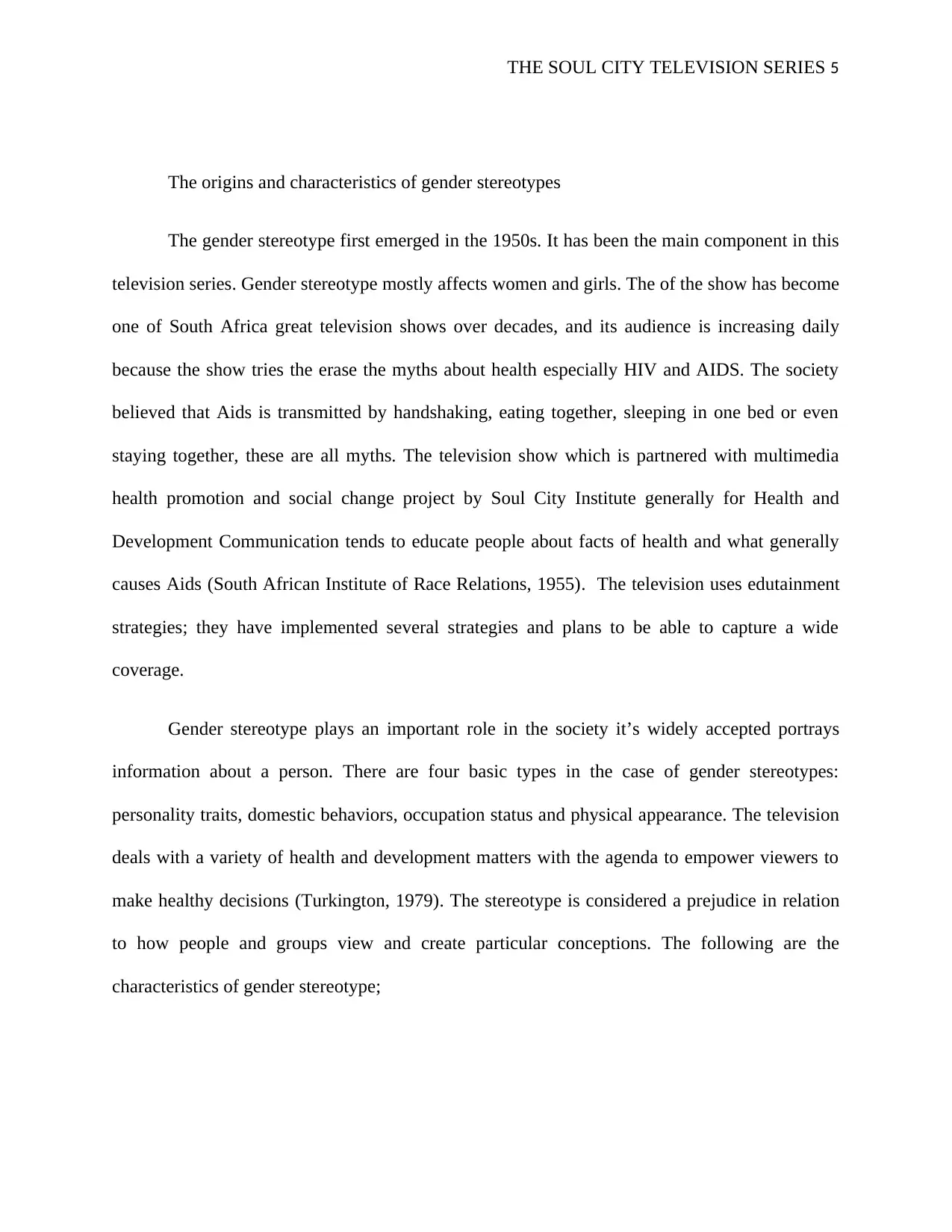
THE SOUL CITY TELEVISION SERIES 5
The origins and characteristics of gender stereotypes
The gender stereotype first emerged in the 1950s. It has been the main component in this
television series. Gender stereotype mostly affects women and girls. The of the show has become
one of South Africa great television shows over decades, and its audience is increasing daily
because the show tries the erase the myths about health especially HIV and AIDS. The society
believed that Aids is transmitted by handshaking, eating together, sleeping in one bed or even
staying together, these are all myths. The television show which is partnered with multimedia
health promotion and social change project by Soul City Institute generally for Health and
Development Communication tends to educate people about facts of health and what generally
causes Aids (South African Institute of Race Relations, 1955). The television uses edutainment
strategies; they have implemented several strategies and plans to be able to capture a wide
coverage.
Gender stereotype plays an important role in the society it’s widely accepted portrays
information about a person. There are four basic types in the case of gender stereotypes:
personality traits, domestic behaviors, occupation status and physical appearance. The television
deals with a variety of health and development matters with the agenda to empower viewers to
make healthy decisions (Turkington, 1979). The stereotype is considered a prejudice in relation
to how people and groups view and create particular conceptions. The following are the
characteristics of gender stereotype;
The origins and characteristics of gender stereotypes
The gender stereotype first emerged in the 1950s. It has been the main component in this
television series. Gender stereotype mostly affects women and girls. The of the show has become
one of South Africa great television shows over decades, and its audience is increasing daily
because the show tries the erase the myths about health especially HIV and AIDS. The society
believed that Aids is transmitted by handshaking, eating together, sleeping in one bed or even
staying together, these are all myths. The television show which is partnered with multimedia
health promotion and social change project by Soul City Institute generally for Health and
Development Communication tends to educate people about facts of health and what generally
causes Aids (South African Institute of Race Relations, 1955). The television uses edutainment
strategies; they have implemented several strategies and plans to be able to capture a wide
coverage.
Gender stereotype plays an important role in the society it’s widely accepted portrays
information about a person. There are four basic types in the case of gender stereotypes:
personality traits, domestic behaviors, occupation status and physical appearance. The television
deals with a variety of health and development matters with the agenda to empower viewers to
make healthy decisions (Turkington, 1979). The stereotype is considered a prejudice in relation
to how people and groups view and create particular conceptions. The following are the
characteristics of gender stereotype;
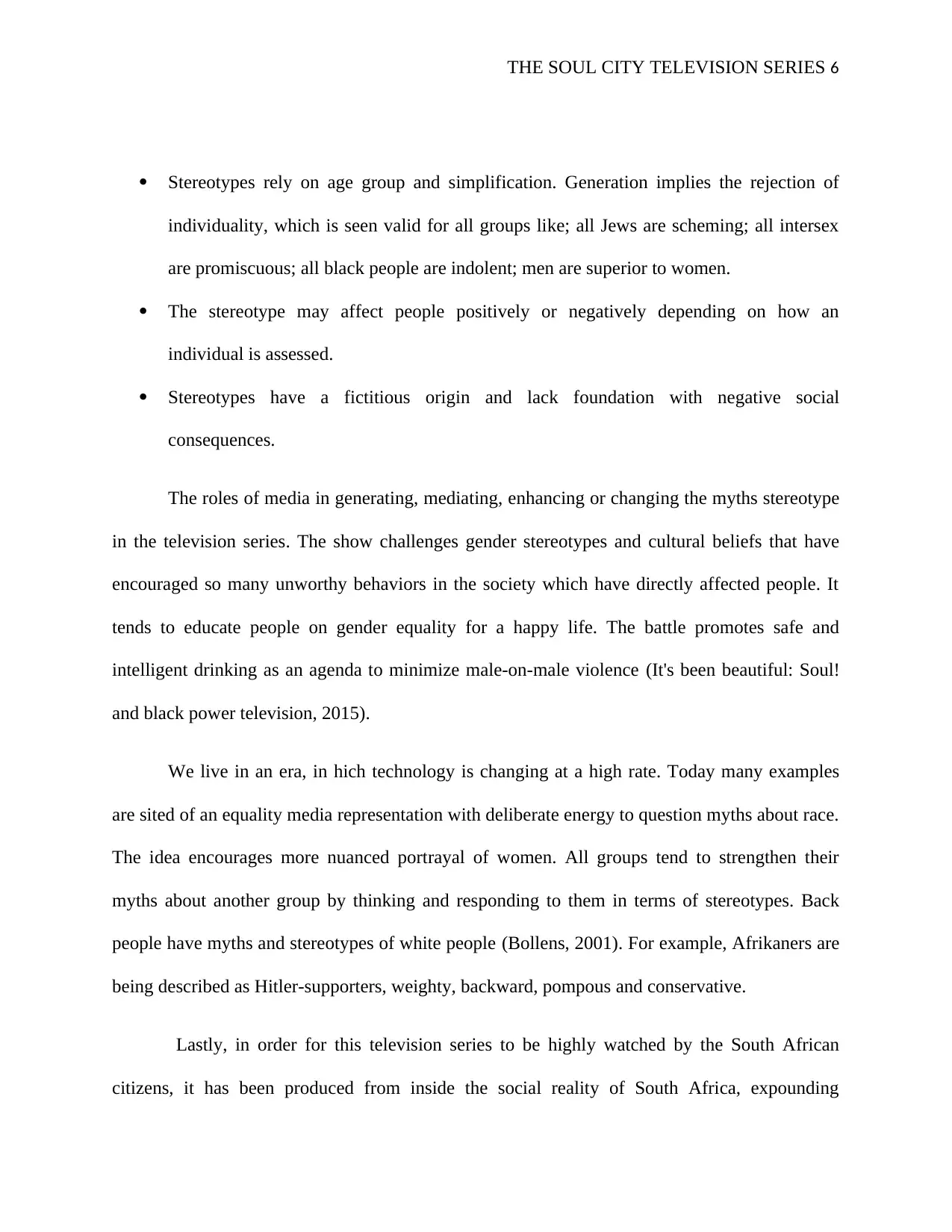
THE SOUL CITY TELEVISION SERIES 6
Stereotypes rely on age group and simplification. Generation implies the rejection of
individuality, which is seen valid for all groups like; all Jews are scheming; all intersex
are promiscuous; all black people are indolent; men are superior to women.
The stereotype may affect people positively or negatively depending on how an
individual is assessed.
Stereotypes have a fictitious origin and lack foundation with negative social
consequences.
The roles of media in generating, mediating, enhancing or changing the myths stereotype
in the television series. The show challenges gender stereotypes and cultural beliefs that have
encouraged so many unworthy behaviors in the society which have directly affected people. It
tends to educate people on gender equality for a happy life. The battle promotes safe and
intelligent drinking as an agenda to minimize male-on-male violence (It's been beautiful: Soul!
and black power television, 2015).
We live in an era, in hich technology is changing at a high rate. Today many examples
are sited of an equality media representation with deliberate energy to question myths about race.
The idea encourages more nuanced portrayal of women. All groups tend to strengthen their
myths about another group by thinking and responding to them in terms of stereotypes. Back
people have myths and stereotypes of white people (Bollens, 2001). For example, Afrikaners are
being described as Hitler-supporters, weighty, backward, pompous and conservative.
Lastly, in order for this television series to be highly watched by the South African
citizens, it has been produced from inside the social reality of South Africa, expounding
Stereotypes rely on age group and simplification. Generation implies the rejection of
individuality, which is seen valid for all groups like; all Jews are scheming; all intersex
are promiscuous; all black people are indolent; men are superior to women.
The stereotype may affect people positively or negatively depending on how an
individual is assessed.
Stereotypes have a fictitious origin and lack foundation with negative social
consequences.
The roles of media in generating, mediating, enhancing or changing the myths stereotype
in the television series. The show challenges gender stereotypes and cultural beliefs that have
encouraged so many unworthy behaviors in the society which have directly affected people. It
tends to educate people on gender equality for a happy life. The battle promotes safe and
intelligent drinking as an agenda to minimize male-on-male violence (It's been beautiful: Soul!
and black power television, 2015).
We live in an era, in hich technology is changing at a high rate. Today many examples
are sited of an equality media representation with deliberate energy to question myths about race.
The idea encourages more nuanced portrayal of women. All groups tend to strengthen their
myths about another group by thinking and responding to them in terms of stereotypes. Back
people have myths and stereotypes of white people (Bollens, 2001). For example, Afrikaners are
being described as Hitler-supporters, weighty, backward, pompous and conservative.
Lastly, in order for this television series to be highly watched by the South African
citizens, it has been produced from inside the social reality of South Africa, expounding
⊘ This is a preview!⊘
Do you want full access?
Subscribe today to unlock all pages.

Trusted by 1+ million students worldwide
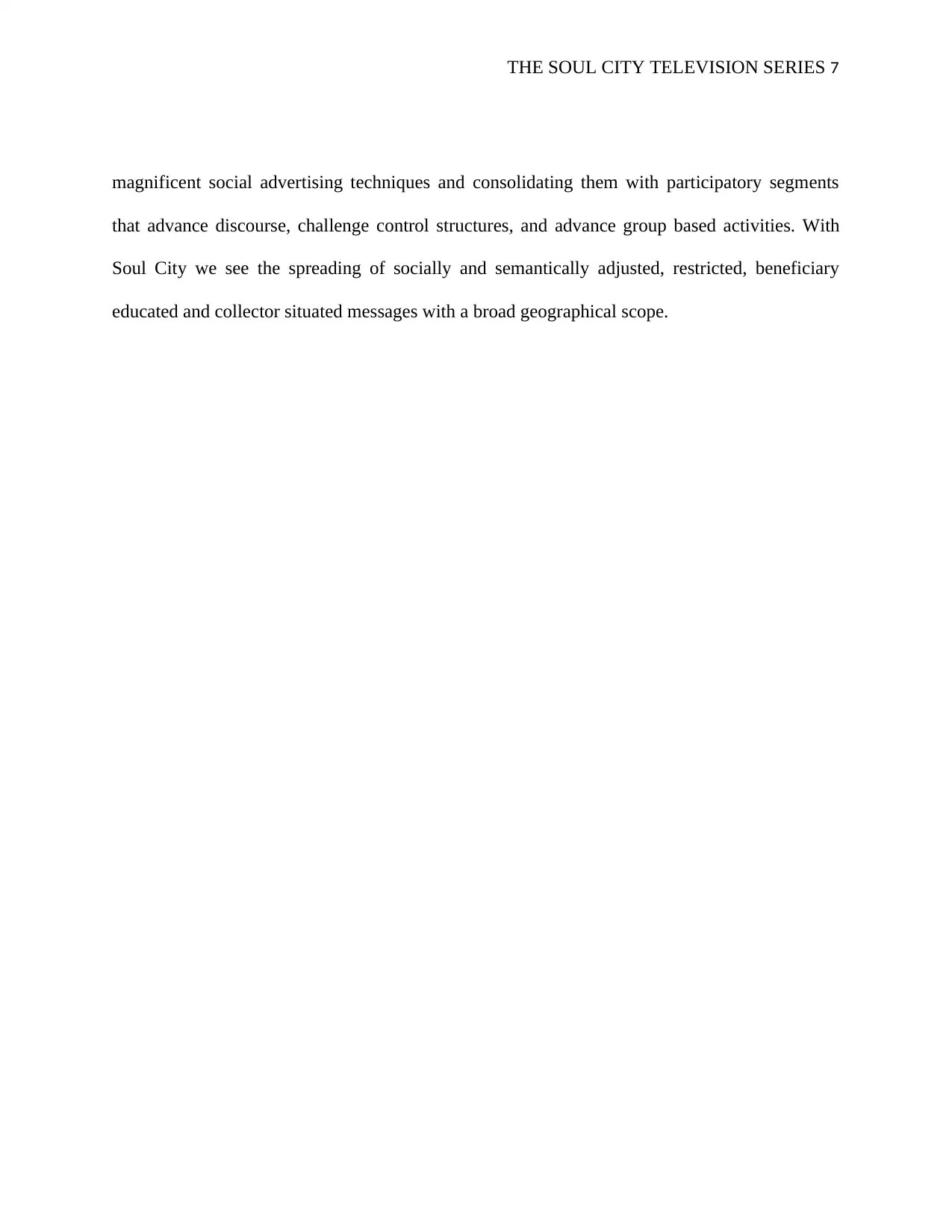
THE SOUL CITY TELEVISION SERIES 7
magnificent social advertising techniques and consolidating them with participatory segments
that advance discourse, challenge control structures, and advance group based activities. With
Soul City we see the spreading of socially and semantically adjusted, restricted, beneficiary
educated and collector situated messages with a broad geographical scope.
magnificent social advertising techniques and consolidating them with participatory segments
that advance discourse, challenge control structures, and advance group based activities. With
Soul City we see the spreading of socially and semantically adjusted, restricted, beneficiary
educated and collector situated messages with a broad geographical scope.
Paraphrase This Document
Need a fresh take? Get an instant paraphrase of this document with our AI Paraphraser
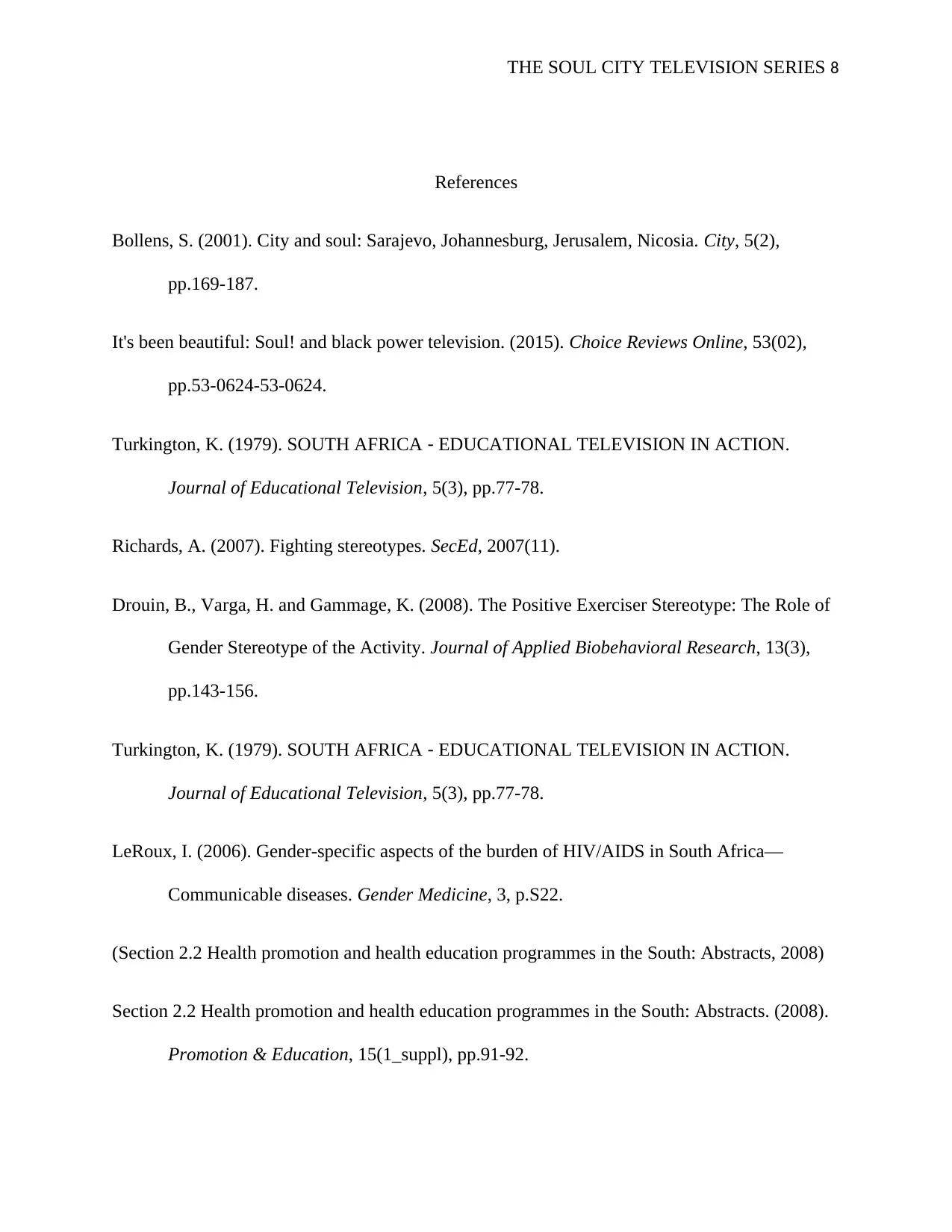
THE SOUL CITY TELEVISION SERIES 8
References
Bollens, S. (2001). City and soul: Sarajevo, Johannesburg, Jerusalem, Nicosia. City, 5(2),
pp.169-187.
It's been beautiful: Soul! and black power television. (2015). Choice Reviews Online, 53(02),
pp.53-0624-53-0624.
Turkington, K. (1979). SOUTH AFRICA ‐ EDUCATIONAL TELEVISION IN ACTION.
Journal of Educational Television, 5(3), pp.77-78.
Richards, A. (2007). Fighting stereotypes. SecEd, 2007(11).
Drouin, B., Varga, H. and Gammage, K. (2008). The Positive Exerciser Stereotype: The Role of
Gender Stereotype of the Activity. Journal of Applied Biobehavioral Research, 13(3),
pp.143-156.
Turkington, K. (1979). SOUTH AFRICA ‐ EDUCATIONAL TELEVISION IN ACTION.
Journal of Educational Television, 5(3), pp.77-78.
LeRoux, I. (2006). Gender-specific aspects of the burden of HIV/AIDS in South Africa—
Communicable diseases. Gender Medicine, 3, p.S22.
(Section 2.2 Health promotion and health education programmes in the South: Abstracts, 2008)
Section 2.2 Health promotion and health education programmes in the South: Abstracts. (2008).
Promotion & Education, 15(1_suppl), pp.91-92.
References
Bollens, S. (2001). City and soul: Sarajevo, Johannesburg, Jerusalem, Nicosia. City, 5(2),
pp.169-187.
It's been beautiful: Soul! and black power television. (2015). Choice Reviews Online, 53(02),
pp.53-0624-53-0624.
Turkington, K. (1979). SOUTH AFRICA ‐ EDUCATIONAL TELEVISION IN ACTION.
Journal of Educational Television, 5(3), pp.77-78.
Richards, A. (2007). Fighting stereotypes. SecEd, 2007(11).
Drouin, B., Varga, H. and Gammage, K. (2008). The Positive Exerciser Stereotype: The Role of
Gender Stereotype of the Activity. Journal of Applied Biobehavioral Research, 13(3),
pp.143-156.
Turkington, K. (1979). SOUTH AFRICA ‐ EDUCATIONAL TELEVISION IN ACTION.
Journal of Educational Television, 5(3), pp.77-78.
LeRoux, I. (2006). Gender-specific aspects of the burden of HIV/AIDS in South Africa—
Communicable diseases. Gender Medicine, 3, p.S22.
(Section 2.2 Health promotion and health education programmes in the South: Abstracts, 2008)
Section 2.2 Health promotion and health education programmes in the South: Abstracts. (2008).
Promotion & Education, 15(1_suppl), pp.91-92.
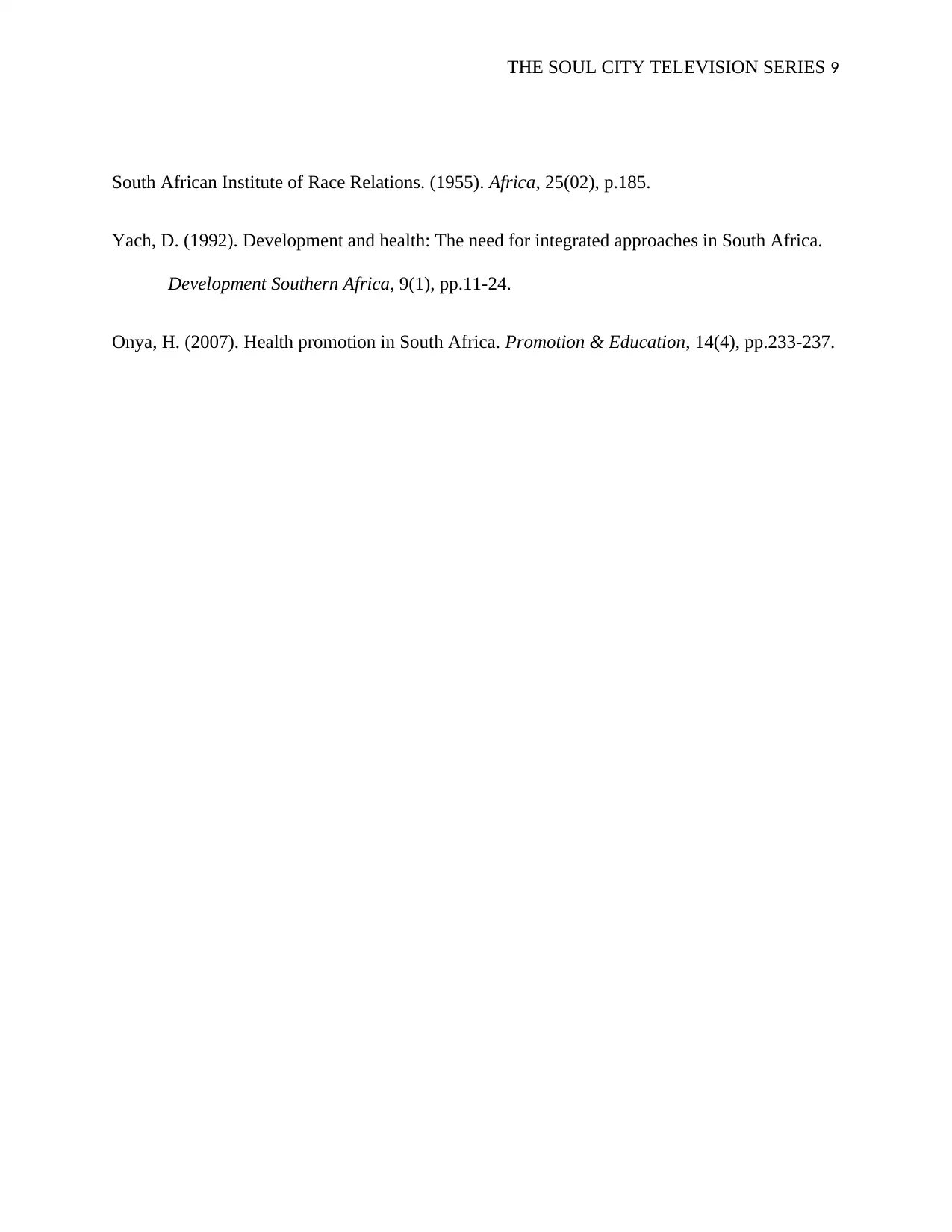
THE SOUL CITY TELEVISION SERIES 9
South African Institute of Race Relations. (1955). Africa, 25(02), p.185.
Yach, D. (1992). Development and health: The need for integrated approaches in South Africa.
Development Southern Africa, 9(1), pp.11-24.
Onya, H. (2007). Health promotion in South Africa. Promotion & Education, 14(4), pp.233-237.
South African Institute of Race Relations. (1955). Africa, 25(02), p.185.
Yach, D. (1992). Development and health: The need for integrated approaches in South Africa.
Development Southern Africa, 9(1), pp.11-24.
Onya, H. (2007). Health promotion in South Africa. Promotion & Education, 14(4), pp.233-237.
⊘ This is a preview!⊘
Do you want full access?
Subscribe today to unlock all pages.

Trusted by 1+ million students worldwide
1 out of 9
Related Documents
Your All-in-One AI-Powered Toolkit for Academic Success.
+13062052269
info@desklib.com
Available 24*7 on WhatsApp / Email
![[object Object]](/_next/static/media/star-bottom.7253800d.svg)
Unlock your academic potential
Copyright © 2020–2025 A2Z Services. All Rights Reserved. Developed and managed by ZUCOL.


